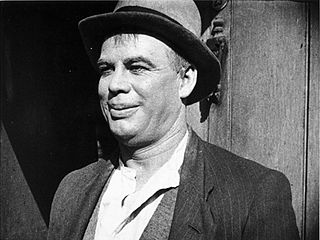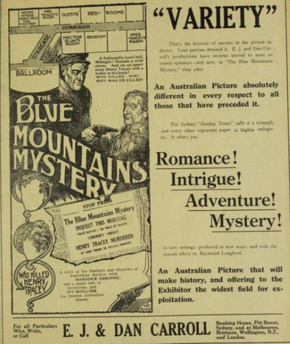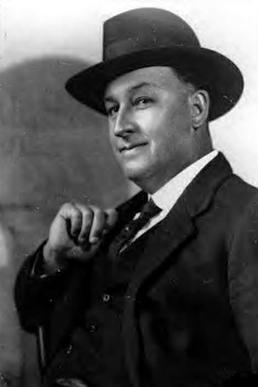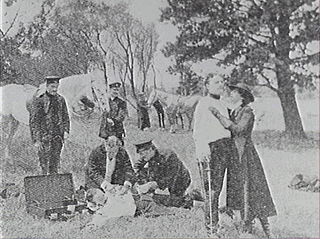
The Sentimental Bloke is a 1918 Australian silent film based on the 1915 verse novel The Songs of a Sentimental Bloke by C. J. Dennis. Produced and directed by Raymond Longford, the film stars Arthur Tauchert, Gilbert Emery, and Lottie Lyell, who also co-wrote the film with Longford.

Margaret Catchpole was an English servant girl, chronicler, and deportee to Australia. Born in Suffolk, she worked as a servant in various houses before being convicted of stealing a horse and escaping from Ipswich Gaol. Following her capture, she was transported to the Australian penal colony of New South Wales, where she remained for the rest of her life. Her entry in the Australian Dictionary of Biography describes her as "one of the few true convict chroniclers with an excellent memory and a gift for recording events".

Richard Cobbold was a British writer.

Lottie Lyell was an Australian actress, screenwriter, editor and filmmaker. She is regarded as Australia's first film star, and also contributed to the local industry during the silent era through her collaborations with director and writer Raymond Longford.

The Blue Mountains Mystery is a lost 1921 Australian silent film directed by Raymond Longford and co-directed by Lottie Lyell.

Raymond Longford was a prolific Australian film director, writer, producer, and actor during the silent era. Longford was a major director of the silent film era of the Australian cinema. He formed a production team with Lottie Lyell. His contributions to Australian cinema with his ongoing collaborations with Lyell, including The Sentimental Bloke (1919) and The Blue Mountains Mystery (1921), prompted the Australian Film Institute's AFI Raymond Longford Award, inaugurated in 1968, to be named in his honour.
Arthur Embery Higgins was a pioneering Australian cinematographer known for his use of trick photography during the silent era. His ongoing collaborations with director Raymond Longford include The Sentimental Bloke (1919) and The Blue Mountains Mystery (1921). He briefly turned to directing with Odds On (1928) however returned to cinematography in 1931 for the remainder of his career.
The Fatal Wedding is a play by Theodore Kremer and a 1911 Australian silent film directed by Raymond Longford based on the melodrama, which he and Lottie Lyell had toured around Australia.
The Tide of Death is a 1912 Australian silent film directed by Raymond Longford based on an original story by Longford. This was rare at the time because most Australian silent films were based on plays or novels.

The Midnight Wedding is a 1912 Australian silent film directed by Raymond Longford based on a popular Ruritanian stage play in which Longford had appeared. It is considered a lost film.
A Maori Maid's Love is a 1916 Australian silent filmwritten and directed by Raymond Longford about an interracial romance between a white man and a Māori girl. It is considered a lost film as there are no known copies.
Ginger Mick is a 1920 Australian silent film directed by Raymond Longford based on The Moods of Ginger Mick by C. J. Dennis, which had sold over 70,000 copies. It is a sequel to The Sentimental Bloke (1919) and is considered a lost film.
The Dinkum Bloke is a 1923 Australian silent film directed by Raymond Longford. Despite the title and the presence of Arthur Tauchert and Lottie Lyell in the cast, the film is not a direct sequel to The Sentimental Bloke (1919) or Ginger Mick (1920).

Alfred Rolfe, real name Alfred Roker, was an Australian stage and film director and actor, best known for being the son-in-law of the celebrated actor-manager Alfred Dampier, with whom he appeared frequently on stage, and for his prolific output as a director during Australia's silent era, including Captain Midnight, the Bush King (1911), Captain Starlight, or Gentleman of the Road (1911) and The Hero of the Dardanelles (1915). Only one of his films as director survives today.

Captain Midnight, the Bush King is a 1911 Australian silent Western film about the fictitious bushranger Captain Midnight. It was the directorial debut of actor Alfred Rolfe. The film is based on the play of same name by W. J. Lincoln and Alfred Dampier. Captain Midnight, the Bush King is now considered lost.
Captain Starlight, or Gentleman of the Road is a 1911 Australian silent film about the bushranger Captain Starlight. It was based on Alfred Dampier's stage adaptation of the 1888 novel Robbery Under Arms. It is considered a lost film.
The Life of Rufus Dawes is a 1911 Australian silent film based on Alfred Dampier's stage adaptation of the 1874 novel For the Term of His Natural Life produced by Charles Cozens Spencer.
Augustus Neville was a New Zealand-born actor who appeared in a number of the early films for director Raymond Longford but was best known for his stage career in Australia, particularly in works by William Shakespeare. He worked for many years with Alfred Dampier and Allan Wilkie.
Philip Lytton, real name Charles Ernest Phillips, was an Australian actor and theatrical entrepreneur best known for producing theatre shows that toured throughout Australia in the early part of the twentieth century. He started as an actor around 1900 and became friends with J. C. Williamson. With Williamson's assistance, he set up acting schools in Sydney and Melbourne, where his students sometimes appeared in Williamson shows.
An English Lass is a 1887 Australian play by Alfred Dampier and C.H. Krieger about Margaret Catchpole, based on a book by Reverend Cobbold. Lily Dampier played Catchpole and Alfred Dampier played Bob the Bosun.









